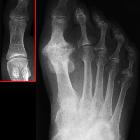Hallux rigidus











Hallux rigidus (osteoarthrosis with restricted motion) is the second most common disabling deformity of the first metatarsophalangeal joint after hallux valgus.
Terminology
Hallux limitus is distinct from hallux rigidus, the former referring to the functional pain secondary to lack of flexibility of the soft tissue structures, e.g. spasm of the gastrocnemius. Nevertheless hallux limitus is thought to be a risk factor for hallux rigidus, therefore features of both conditions may co-occur .
Epidemiology
It is most commonly seen in middle-aged patients but can develop during adolescence. Unlike a hallux valgus, males appear to be slightly more affected than females.
Clinical presentation
Patients present with foot pain. The disability resulting from hallux rigidus is actually greater than that seen in hallux valgus because dorsiflexion at the metatarsophalangeal joint is severely restricted and painful. Removal of shoes does not relieve the pain.
Radiographic features
Plain radiograph
The hallmark is osteoarthritis of the first MTP joint.
The grading system by Hattrup and Johnson is a radiographic classification which is commonly used:
- grade 1: mild to moderate osteophyte formation but with good joint space preservation
- grade 2: moderate osteophyte formation with joint space narrowing and subchondral sclerosis
- grade 3: marked osteophyte formation and loss of the visible joint space, +/- subchondral cyst formation
There is also the Coughlin and Shurnass classification :
- grade 0
- dorsiflexion 40-60°
- normal plain radiograph
- no pain
- grade 1
- dorsiflexion 30-40°
- dorsal osteophytes
- minimal or no other joint changes
- grade 2
- dorsiflexion 10-30°
- mild to moderate joint narrowing or sclerosis
- presence of osteophytes
- grade 3
- dorsiflexion less than 10°
- severe radiographic changes
- constant moderate to severe pain at extremities
- grade 4
- stiff joint
- severe changes with loose bodies and osteochondritis dissecans
Siehe auch:
- Hallux valgus
- Podagra
- Keller-Brandes Grundgliedbasisresektion
- Cheilektomie
- Großzehengrundgelenksarthrodese
- Operation nach Moberg
und weiter:

 Assoziationen und Differentialdiagnosen zu Hallux rigidus:
Assoziationen und Differentialdiagnosen zu Hallux rigidus:


